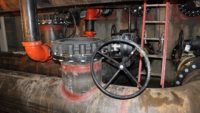From innovations in materials and manufacturing processes to the growing emphasis on environmental sustainability and digital transformation, the pipe, valves and fittings (PVF) industry is undergoing significant changes. As we stand at the threshold of a new era marked by technological advancements, evolving consumer demands and global shifts, understanding the trends shaping the PVF industry has never been more important. PM Engineer Chief Editor Nicole Krawcke had the chance to speak with several key industry stakeholders about trends and technological developments in the market, including: Greg Nahrgang, vice president, technical services and product development, Charlotte Pipe and Foundry; Adam Botts, product manager for Viega; and Steven Dolejsi, applications engineering manager, IPEX.
PM Engineer: What are the biggest trends currently shaping the PVF industry in commercial applications?
Nahrgang: Instead of just using one piping material for an entire project, we are seeing engineers and contractors apply value engineering down to individual sections of the project. For example, on drain, waste, and vent (DWV) lines, it is becoming more commonplace to see specialty coated cast iron in the commercial kitchen area, standard coated cast iron for the rest of the laterals and main waste stack, and PVC for some laterals and the vent lines.
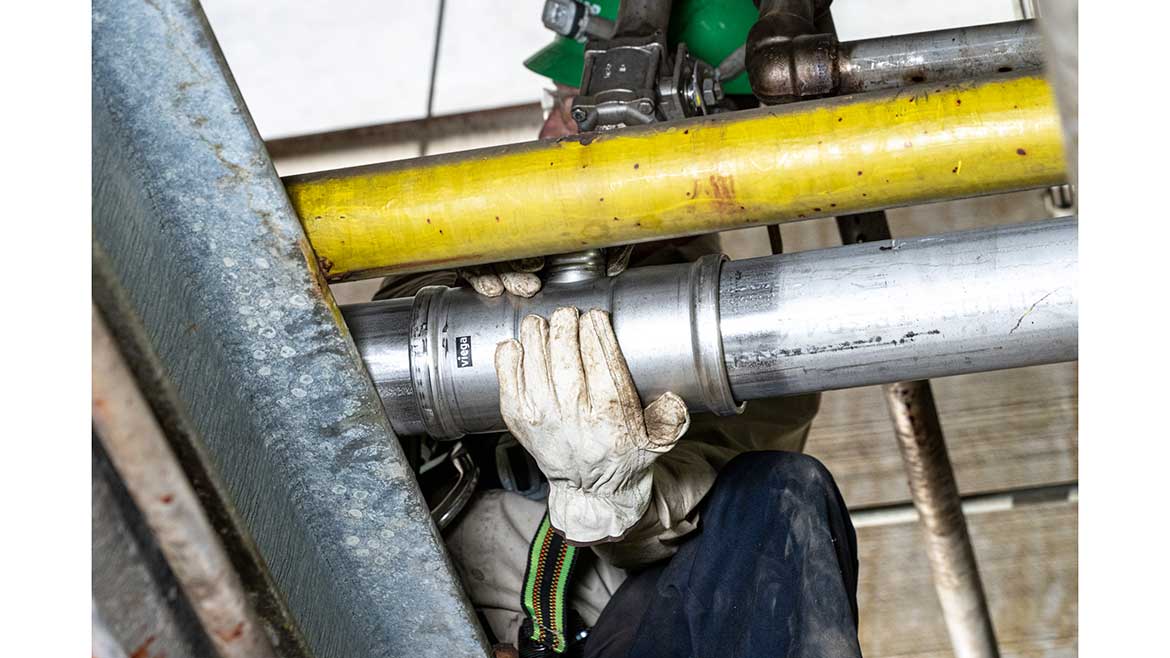
According to Viega's Adam Botts, increasingly, building owners and developers prioritize sustainability in their projects, driving demand for eco-friendly plumbing solutions.
Botts: There is increasing demand for smart plumbing systems that integrate IoT technology in a similar fashion to what the HVAC sector has done with thermostats. These systems allow for remote monitoring and control of plumbing fixtures, leading to enhanced efficiency, reduced maintenance costs, and improved building management, specifically in sub-metering and leak detection. Additionally, there is a growing emphasis on water conservation and energy efficiency, driven by regulatory requirements and environmental concerns. This has spurred the development of high-efficiency fixtures and fittings designed to minimize water usage while maintaining optimal performance. Moreover, the adoption of modular and prefabricated plumbing solutions is gaining traction in the commercial sector due to their ability to streamline installation processes and reduce construction timelines.
Dolejsi: The PVF industry is continuously evolving but we are seeing a growing emphasis on environmentally responsible manufacturing, specifically on the use of sustainable materials and designing energy efficient systems to decrease energy consumption and to ultimately reduce operational costs and environmental impact.
PM Engineer: What is driving these trends?
Nahrgang: I think it is an evolution of the value engineering process. Traditionally, engineers and contractors have looked at material selection holistically for the entire project. Then, they started evaluating underground and above-ground materials separately. Therefore, it is a natural progression to consider factors like temperature, pH of the effluent, and maintenance concerns for different areas of a project.
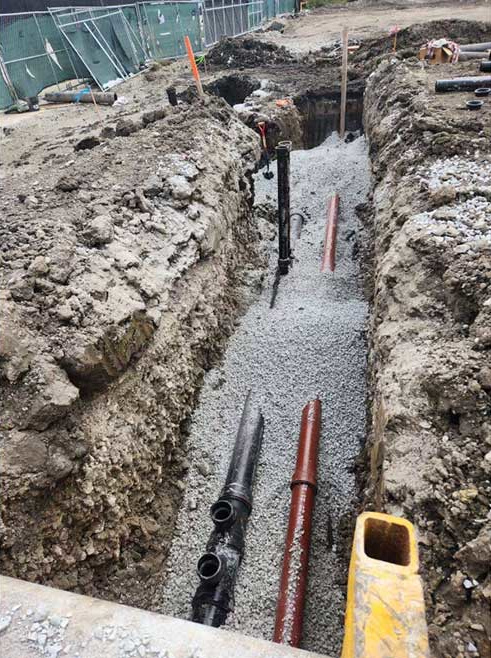
Charlotte Pipe's Edge HP Iron is the most recent innovative product. The manufacturer reams the ID of Edge twice and shot blast the OD to prepare the pipe’s surface to be coated. Three layers of coatings are then applied so the product will withstand aggressive DWV applications such as parking garages, exposure to salt spray from the ocean and undiluted cleaning chemicals.
Botts: Regulatory requirements play a significant role, particularly in promoting water conservation, energy efficiency, and more recently electrification. Building codes and standards are increasingly stringent, mandating the use of eco-friendly and energy-efficient plumbing systems. The growing awareness of environmental sustainability among building owners, architects, and engineers is driving demand for innovative solutions that minimize resource consumption and carbon footprint in line with programs such as LEED, the Living Building Challenge, and WELL buildings.
Dolejsi: There are several factors driving these trends. We’re seeing an increasing awareness of our planet. Changes in regulations and standards are being implemented globally and require manufacturers to adapt their operations and products to these changes, driving innovations and new technologies in the industry.
PM Engineer: What innovative features or technologies are integrated into your PVF products to enhance performance and efficiency?
Nahrgang: Our Edge HP Iron is the most recent innovative product from Charlotte Pipe. We ream the ID of Edge twice and shot blast the OD to prepare the pipe’s surface to be coated. We then apply three layers of coatings so the product will withstand aggressive DWV applications such as parking garages, exposure to salt spray from the ocean and undiluted cleaning chemicals. Because the installation and dimensions are the same as standard cast iron, Edge is specified for the aggressive areas only and you transition back to standard cast iron.
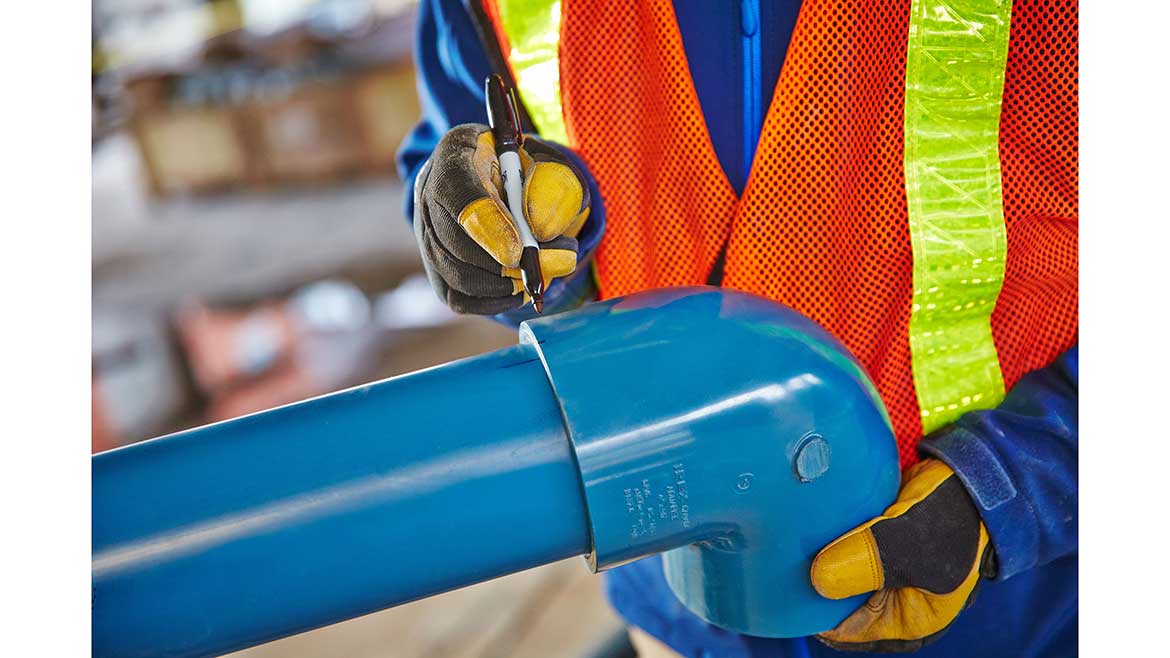
According to IPEX's Steven Dolejsi, the PVF industry is continuously evolving and IPEX is seeing a growing emphasis on environmentally responsible manufacturing, specifically on the use of sustainable materials and designing energy efficient systems to decrease energy consumption and to ultimately reduce operational costs and environmental impact.
Botts: Viega is actively pursuing integration of smart valves and fittings equipped with IoT sensors and our valve lineup has standard ISO mounting pads for any actuators already on the market. These smart components can enable remote monitoring and control of water flow, temperature, and pressure, providing real-time insights into system performance and enabling proactive maintenance. Furthermore, our ProPress solutions are intrinsically antimicrobial, enhancing hygiene and preventing bacterial growth, ensuring a safer and healthier environment for building occupants.
PEX tubing, which offers benefits for residential and commercial plumbing applications, is renowned for its flexibility, durability, and corrosion resistance, making it an ideal choice for a wide range of plumbing systems. Its flexibility allows for easy installation in complex layouts, reducing labor costs and installation time compared to traditional rigid piping materials. PEX is highly resistant to chemical degradation, ensuring long-term reliability and minimal maintenance requirements as we have the highest rating for chlorine resistance. Contrary to common thought, PEX can be considered a sustainable solution, as it is manufactured using environmentally friendly materials and processes. It has a lower environmental impact compared to other piping materials like copper or steel, requiring fewer resources and energy during production. There are also newly developed processes that can break PEX down and make it recyclable at the end of its service life, contributing to a circular economy and reducing waste.
Dolejsi: We are always pushing the boundaries of innovation and new ways to enhance the quality of our products while looking for ways to reduce water consumption, waste and the amount of energy needed to manufacture.
IPEX manufactures PVF out of thermoplastic materials which are lightweight, corrosion resistant and have a low carbon footprint compared to traditional materials. Lightweight pipe means that less energy is needed to transport and install.
Thermoplastics have a long operating life, often over 50 years in water conveyance. During that lifetime, they offer several advantages, such as: better insulative properties, smoother inner wall, and greater resistance to biofilm build up. This means that a commercial water system can produce higher water quality while also reducing energy use.
The great news is that after the system has reached the end of its operating life, most thermoplastics are completely recyclable. IPEX also manufactures high-quality thermoplastic valves with optimized flow to reduce pressure loss and further increase energy efficiency.
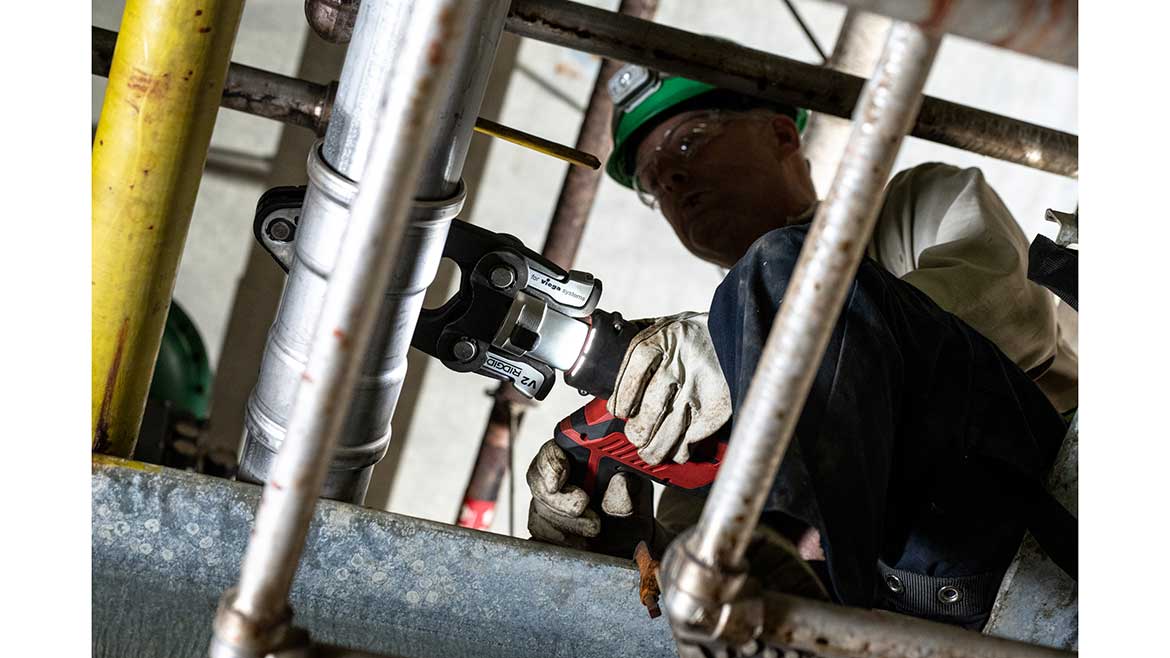
Viega continues to expand its North American footprint with expansions in its factory in Kansas as well as breaking ground recently on a second fabrication facility in Ohio. These investments of over $250M show Viega’s dedication to the market and our expectations to supply forecasted demands.
PM Engineer: How does your company stay abreast of technological developments and incorporate them into your product offerings?
Nahrgang: It is critical that we listen to the people who install, buy, and specify our products. To this end, our reps, sales managers, and technical service associates are constantly in the field interacting with customers as they work with our products. We also believe that attending trade shows is essential for keeping up with the latest technologies and trends. Once we understand our customers’ needs, we take projects through our stage-gate product development process which is overseen by a cross-functional Product Development Committee.
Botts: We actively engage in continuous research and development efforts to identify emerging technologies and trends that have the potential to enhance our product offerings. This involves closely monitoring industry publications, attending trade shows and conferences, and participating in collaborative research projects with academic institutions and industry partners. Additionally, we maintain open channels of communication with our customers to gather feedback on their evolving needs and preferences. By leveraging insights from these sources, we can incorporate technological advancements and regulatory changes into our product development process, ensuring that our offerings remain innovative and competitive in the market.
Dolejsi: We use a combination of our own research and development, collaboration with industry experts, speaking with our customers, attending conferences and trade shows and keeping a close eye on industry trends and reports to understand real-world experiences and concerns. We take this information back to the team and use it to fuel our innovation and to develop new technologies and best practices.
PM Engineer: How do sustainable practices influence product design and end-user preferences in commercial applications? Can you discuss any efforts to reduce waste or promote recycling throughout the product lifecycle?
Nahrgang: Charlotte Pipe has always reinvested heavily in our operations to help ensure our customers get the products they need, when they need them. The most recent example is a $460M state-of-the-art foundry that became operational last year. Relocating and expanding our foundry enables us to better support our customers. The improved processes, production capacity, and environmental practices used here will allow Charlotte Pipe to more effectively serve the plumbing industry for another 100 years and beyond. In addition, we have added a tremendous amount of plastic pipe and fitting capacity in recent years. We are about to break ground on a new, $80M plastic pipe manufacturing facility in Maize, KS, just outside of Wichita. Maize is ideally located in the center of the country to help us better serve our customers.
Botts: Increasingly, building owners and developers prioritize sustainability in their projects, driving demand for eco-friendly plumbing solutions. On the copper side and steel side, the circular economy is already present in the form of a multitude of recycling centers that divert landfill waste back into the recycled component of raw materials. In terms of product design and lifecycle management strategies with sustainability principles, we are integrating sustainability into our processes, not adding it as another step. In this way, sustainable decisions become a part of what we do, not just an “add-on” for the sake of itself.
Dolejsi: At IPEX, we have a unique position and opportunity in our approach to environmentally responsible manufacturing. We have made this important global concern a major pillar of how we operate our business, and we are undertaking numerous initiatives in the areas of carbon reduction, renewable electricity, recycling, water consumption and waste management to meet our environmental goals. For example, as part of our global standards and new development processes, one of our checklist items requires us to examine and consider the sustainable impact of products.
Recycling is central to our operations at IPEX. At one of our plants in Quebec, Canada, each year, we divert post-industrial scrap from the landfill, including pieces from old construction projects, scrap from other manufacturers and home components such as siding, doors, window frames and flooring. As part of our Enviro-Tite products, these end-of-life scraps are recycled into durable, long-lasting pipes that deliver clean water and sanitation.
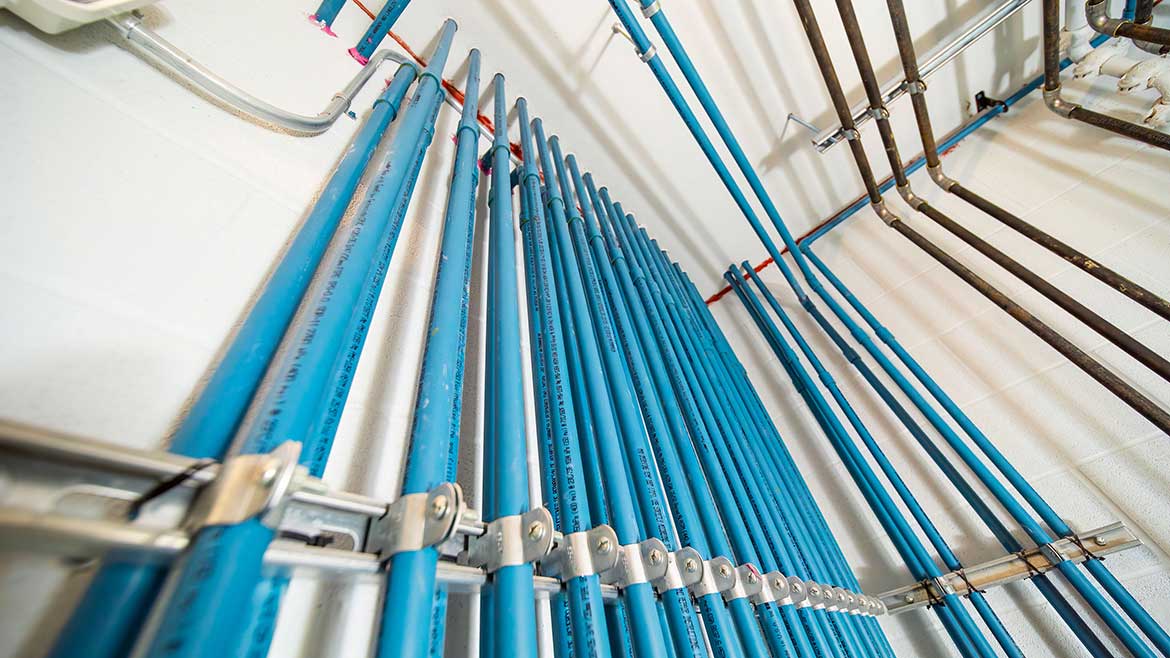
IPEX’s AquaRise potable water piping system is installed in an application in Windsor, Ontario. A tough and robust potable water distribution solution, it is designed specifically to support commercial, industrial and high-rise buildings.
PM Engineer: How do you ensure consistency and reliability in product availability, especially for large commercial projects? What measures are in place to mitigate supply chain disruptions or delays?
Botts: We employ several measures to achieve this goal, starting with robust supply chain management practices. Our company maintains strategic partnerships with trusted suppliers and distributors to secure a steady and reliable flow of materials and components. Additionally, we invest in advanced inventory management systems and demand forecasting tools to optimize stock levels and anticipate fluctuations in demand. In the event of supply chain disruptions or delays, we have contingency plans in place, such as alternative sourcing options, safety stock provisions and expedited shipping arrangements. Moreover, we prioritize clear and transparent communication with customers to proactively address any potential issues and minimize the impact on project timelines. By implementing these measures, we strive to deliver consistent and reliable product availability to support the success of these, and all projects. We continue to expand our North American footprint with expansions in our factory in Kansas as well as breaking ground recently on a second fabrication facility in Ohio. These investments of over $250M show Viega’s dedication to the market and our expectations to supply forecasted demands.
Dolejsi: IPEX prides itself on our customer-first culture. A big part of that is ensuring customers get quality product when they need it. As part of our multi-year strategy, IPEX is investing in the expansion of its warehousing and distribution capabilities and facilities across North America. This allows us to better serve our customers by having products efficiently and strategically stocked to create flexibility at our distribution centers across Canada and the U.S.
Between IPEX’s strong relationships with regional and national distributors and our extensive network of sales professionals and application engineers, we provide local inventory and product support while facilitating seamless installations.
PM Engineer: How do you anticipate future market demands and technological advancements?
Nahrgang: Most importantly, we know and listen to our customers. Our material and equipment vendors also provide an important role in advancing technology.
Botts: We conduct market research and trend analysis to identify emerging opportunities and potential areas for growth. Additionally, we leverage insights from industry experts, trade associations, and regulatory bodies to stay informed about regulatory changes, technological innovations, and shifting market dynamics. We also foster a culture of innovation and continuous improvement within our organization, embodied by our slogan, “Connected in Quality.”
Dolejsi: By being active in the industry, talking to the experts within the industry (engineers, contractors, end users) and participating in industry events that discuss the needs of the market.
PM Engineer: Are there any emerging trends or disruptive technologies that are expected to influence the PVF industry in the coming years?
Nahrgang: I think that we will continue to see Value Engineering at a more granular level as I mentioned earlier. One piping material may not be best suited for an entire project. This approach allows a building owner to have the highest functioning building at the most economical cost. Although not specific to the PVF industry, AI is a disruptive technology that we need to learn, understand, and figure out where it makes sense to implement.
Botts: As electrification initiatives gain momentum, there may be increased focus on transitioning away from traditional gas-powered appliances and infrastructure toward electric alternatives. This shift could lead to decreased demand for gas piping systems in certain applications, particularly in residential and commercial buildings where electrified heating, cooling, and cooking solutions are increasingly favored for their perceived environmental benefits and energy efficiency. We are always on the lookout for advancements in material science that lead to the development of stronger, lighter, and more durable products. In the same way, packaging is a major source of improvement that can be made for our products as we keep an eye on truly biodegradable plastics and ways to reduce packaging overall while maintaining the high quality of products delivered that our partners have come to trust.
Dolejsi: We are going to continue to see an increased emphasis on environmentally responsible manufacturing with a focus on product life cycles and reducing waste/environmental impact. There will also be a focus on AI (Artificial Intelligence) and automation in relation to supply chain management and optimizing manufacturing processes.




